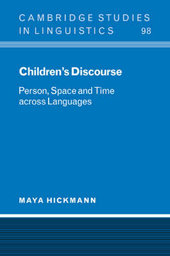
|
Children's Discourse: Person, Space and Time across Languages
Paperback / softback
Main Details
| Title |
Children's Discourse: Person, Space and Time across Languages
|
| Authors and Contributors |
By (author) Maya Hickmann
|
| Series | Cambridge Studies in Linguistics |
|---|
| Physical Properties |
| Format:Paperback / softback | | Pages:412 | | Dimensions(mm): Height 228,Width 151 |
|
| ISBN/Barcode |
9780521065108
|
| Classifications | Dewey:401.93083 |
|---|
| Audience | | Professional & Vocational | |
|---|
| Illustrations |
14 Tables, unspecified
|
|
Publishing Details |
| Publisher |
Cambridge University Press
|
| Imprint |
Cambridge University Press
|
| Publication Date |
12 June 2008 |
| Publication Country |
United Kingdom
|
Description
This comparative study explores two central questions in the study of first language acquisition: What is the relative impact of structural and functional determinants? What is universal versus language-specific during development? Maya Hickmann addresses these questions in three domains of child language: reference to entities, the representation of space, and uses of temporal-aspectual markings. She provides a thorough review of different theoretical approaches to language acquisition and a wide range of developmental research, as well as examining all three domains in English, French, German and Chinese narratives. Hickmann's findings concern the rhythm of acquisition, the interplay among different factors (syntactic, semantic, pragmatic) determining children's uses, and universal versus variable aspects of acquisition. Her conclusions stress the importance of relating sentence and discourse determinants of acquisition in a crosslinguistic perspective. Children's Discourse will be welcomed by those working in psychology and language-related disciplines interested in first language acquisition.
Author Biography
Maya Hickmann is Research Director at Laboratoire Cognition et Developpement, Centre National de la Recherche Scientifique and University of Paris V.
ReviewsFrom the hardback review: '... this book remains one of the most impressive in the field of language acquisition. The richness of the data from four different languages is truly striking, and linguists in almost any subfield of linguistics are guaranteed to learn much of value from this book.' Linguistics
|